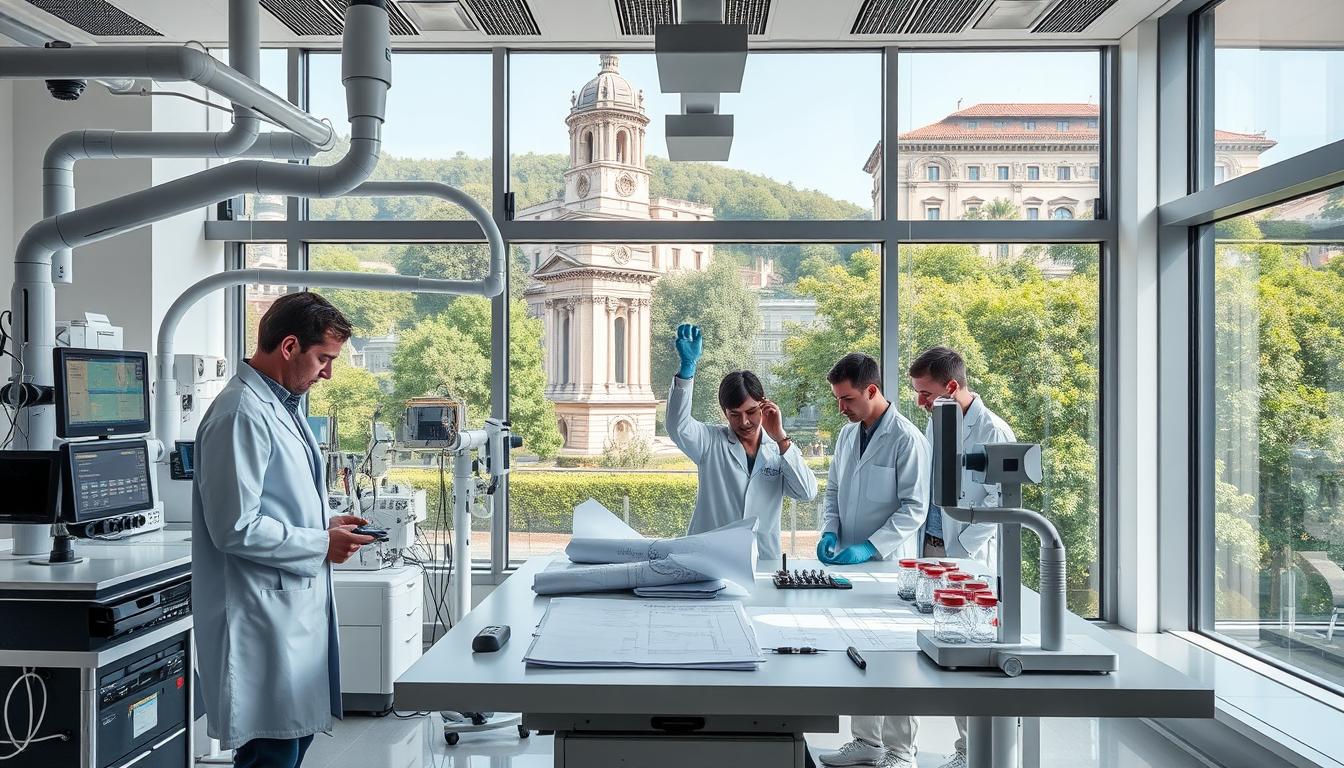Exploring the Italian healthcare market is exciting. Peter Drucker once said, “The best way to predict the future is to create it.” This idea is perfect for those wanting to start a medical device company in Italy. It’s not just a chance; it’s a big responsibility.
Starting a medical device company means understanding complex rules and the market. You need to know about EU directives and local laws. Since May 1, 2007, all devices must be registered. This includes different types of devices and the Italian Medical Device Registry.
We’ll look at all the steps needed. From setting up our business to following Italian Ministry of Health rules. This will help us succeed in this challenging but rewarding field.
Understanding the Italian Medical Device Market
Italy is a big player in the healthcare world, ranking fourth in Europe’s medical device market. In 2021, the market was worth around $11.8 billion. This shows a lot of potential for growth.
There are about 4,500 companies in this market. 53% of them make devices, 42% sell them, and 5% offer services. Most devices are bought by public hospitals, which use over 75% of the market.
Market Overview and Potential
In 2023, Italy made about $9.3 billion worth of medical devices. But, it also imported $7.4 billion worth. This shows Italy relies on other countries for many devices.
The Netherlands and Germany are the top suppliers. The Italian government is also investing in healthcare. They’ve set aside €235 million for basic diagnostics and €1.18 billion for the National Recovery and Resilience Program.
Key Statistics and Data
The market is moving towards value-based healthcare due to costs and budget issues. In 2022, e-health spending was $1.98 billion, or 1.2% of total healthcare costs. New EU rules, like getting the CE mark, also affect the market.
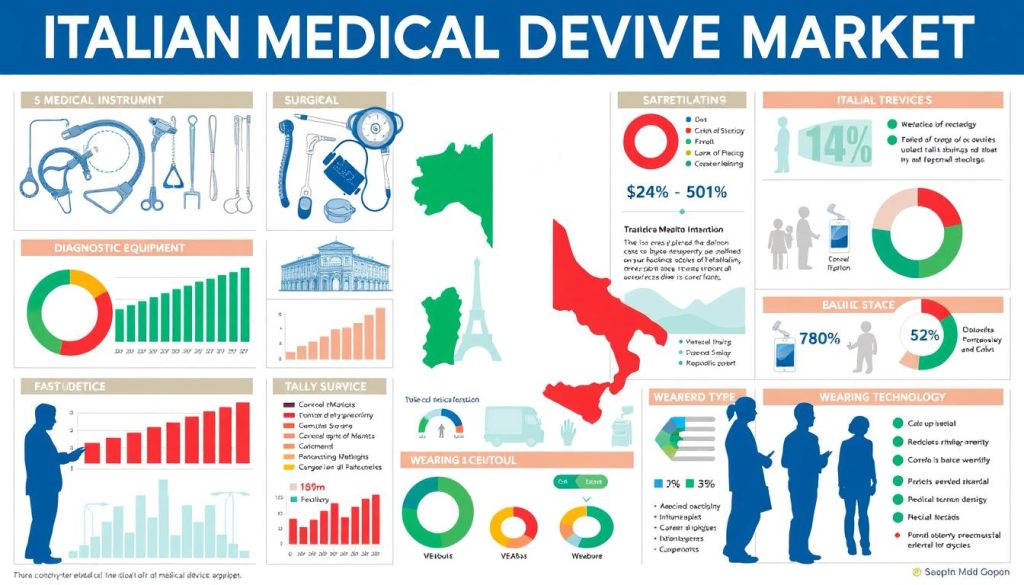
Regulatory Landscape for Medical Devices in Italy
Knowing the rules is key for companies wanting to enter Italy’s medical device market. They must follow EU laws and Italy’s own rules to succeed. The Italian Ministry of Health is at the heart of these regulations.
EU Medical Device Regulation Framework
The EU Medical Device Regulation (MDR) 2017/745 has strict rules for makers of medical devices in the EU. This includes those selling in Italy. They must register their products to show they are safe and work well.
Companies outside the EU need an EU Authorized Representative. They must also keep detailed records. This shows how important it is to follow the laws and rules.
Italian Ministry of Health Requirements
The Italian Ministry of Health has its own rules for medical devices. Devices must be listed in the Medical Device Register. This requires detailed information about the product and its CND codes.
These rules have been in place since May 1, 2007. Companies must keep their information up to date to stay legal. This includes reporting on safety and following marketing rules to sell in Italy.
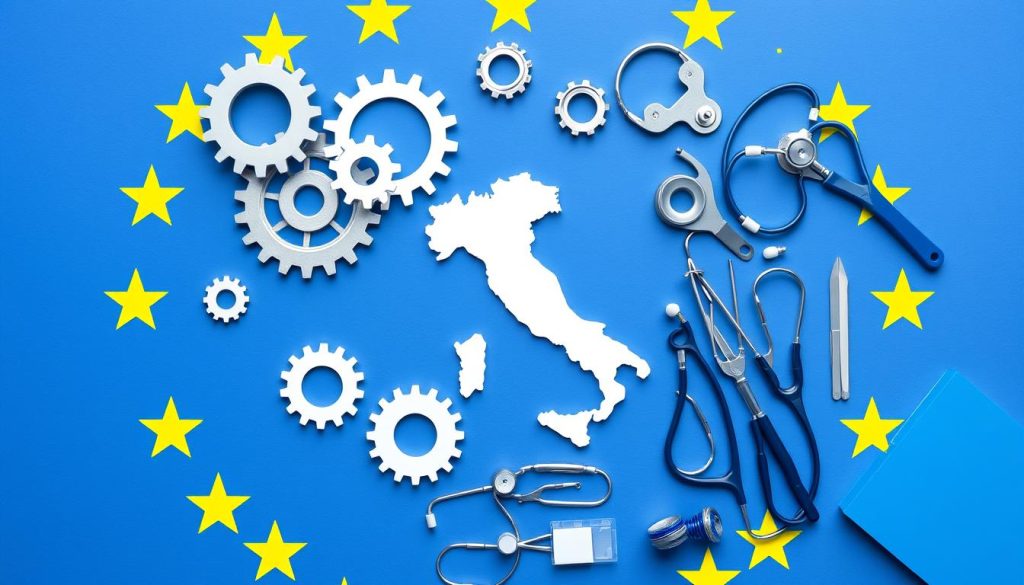
Getting Started with Your Medical Device Company
Starting a medical device company in Italy means first defining our business model. A good medical device business model helps us understand the healthcare sector’s challenges and opportunities. We must pay close attention to several key factors during this planning phase.
Defining Your Business Model
Our startup strategy must include a detailed market analysis. This helps us find gaps in current products. We also need to know the competitive landscape to find our unique value for healthcare providers. Key aspects of a strong medical device business model include:
- Market Segmentation: It’s vital to know our target customers to tailor our products to their needs.
- Distribution Channels: Setting up efficient ways to distribute our products ensures they reach our audience effectively.
- Pricing Strategies: Understanding our costs helps us set prices that are competitive yet profitable.
- Customer Needs: Talking to potential users gives us valuable insights to improve our devices.
- Regulatory Compliance: Knowing about regulatory approvals, like FDA or CE marking, is key for launching our products.
A detailed business plan will outline our goals, how we will operate, and our financial forecasts. It’s important to consider funding options like venture capital, angel investors, and government grants. With careful planning and a focus on innovation, we can succeed in Italy’s competitive medical device market.
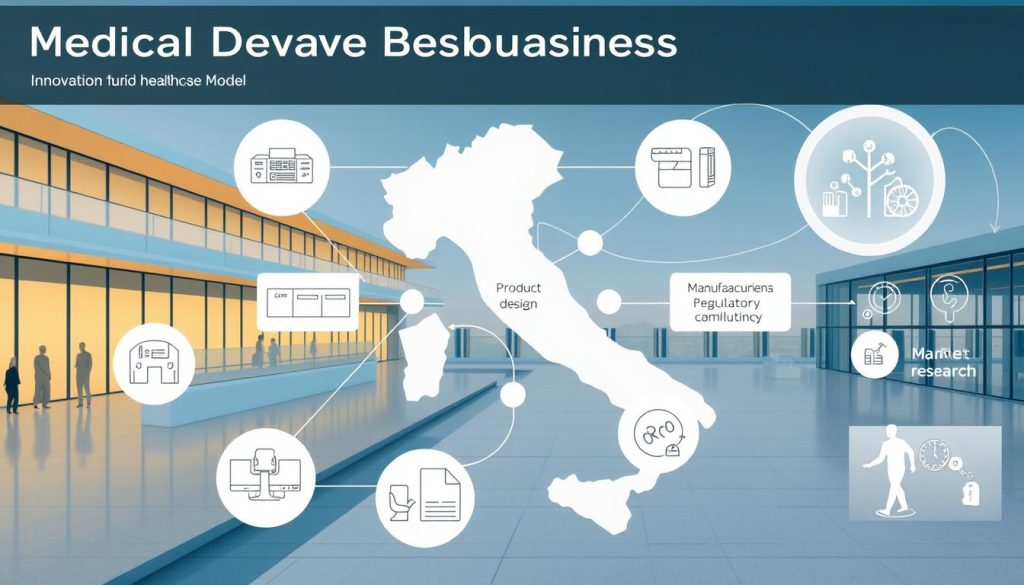
Establishing a Legal Entity in Italy
Starting a company in Italy means setting up a legal entity that fits our business aims. Picking the right structure is key. It affects how we work and follow the law in Italy.
Choosing the Right Business Structure
In Italy, there are many business types, each with its own rules. For example:
- Individual Enterprise: Good for freelancers and solo businesses with simple needs.
- Partnership: For two or more people sharing work and profits but also risks.
- Limited Liability Company (LLC): Protects personal assets, vital for medical device businesses.
Knowing the legal needs of each type helps us choose wisely. We must think about taxes and what we need to do to run our business right.
Registering Your Business
Registering our business is when we officially start our medical device company in Italy. We need to give the Italian Business Register some important documents, like:
- Proof of who we are and where we live.
- Where our business is located.
- What we plan to do in business.
Getting our business registered right is crucial for following the law and getting the right permits. This lets us work well in the competitive medical device market. It helps us grow and succeed.

Navigating Registration Compliance for Medical Devices
To register medical devices in Italy, you need to understand the process well. Since 2007, companies have had to navigate compliance rules. Domestic firms use the “Portale delle Imprese”, while foreign ones use the “Nuovo Sistema Informativo Sanitario”.
Medical Device Database Registration Process
The process has different steps for each product type. Companies must clearly state their device’s class. There are four main classes: Class I, Class IIa, Class IIb, and Class III.
Each class has its own rules for registration and monitoring. Custom-made devices and in vitro diagnostics have special rules too. So, detailed documentation is key.
Understanding Classifications and Requirements
Knowing the differences between classes is crucial for compliance. Agencies like the European Medicines Agency and the U.S. Food & Drug Administration have different rules. Keeping up with these changes is vital.
Using a Regulatory Information Management System (RIMS) helps a lot. It makes tracking changes easier and keeps documents in order. This way, we can speed up the registration process and keep everything traceable.
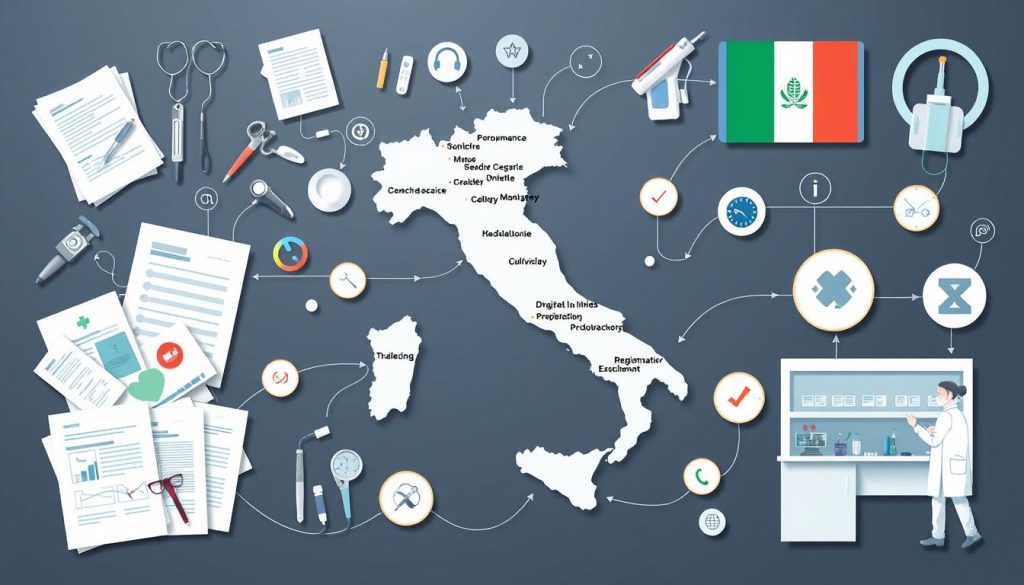
The Importance of an EU Authorized Representative
Entering the Italian medical device market is challenging, especially for non-EU makers. An EU Authorized Representative is key. They ensure our products meet European rules and regulations.
Choosing an Authorized Representative
Choosing the right EU Authorized Representative is crucial. They help us meet European Union legal needs. They also help with the paperwork needed for authorities or Notified Bodies.
They play a big part in our compliance efforts. They watch over our devices in the EU market. They also report any safety issues, keeping our standards high.
It’s important they have a base in Europe. This makes talking to authorities easier. Lorit Consultancy, for example, helps with paperwork and safety standards.

Technical Documentation for Medical Device Companies
In the medical device world, detailed technical documentation is key. It helps meet medical device needs and follow rules. This includes product files, clinical reports, and risk management documents. A good technical file is vital for regulatory submissions and keeping up with EU rules.
Essential Documentation Requirements
The Medical Device Regulation (MDR) started in May 2021, replacing the MDD. Annex II of the MDR lists what technical documentation needs. This includes a UDI code, how it works, testing, labels, and design and making details. Following these rules makes sure our products are up to standard.
- UDI Codes
- Device classification rationale
- Safety and performance specifications
- Benefit-risk analysis
- Proactive post-market surveillance strategy
The In Vitro Diagnostic Regulation (IVDR) took over in May 2022, raising the bar for in vitro diagnostic devices. We must use IVDR Annex II and III for our technical documents.
Quality Management System Fundamentals
Having a Quality Management System (QMS) that follows MDR and IVDR rules is crucial. This system ensures quality and helps create detailed technical documents. A good QMS follows ISO 13485, with clear procedures and manuals for top performance.
Our technical documents show our dedication to quality management. They include a medical device file with details, purpose, labels, specs, and market data. Checking our technical documents against rules and our QMS ensures we meet standards and follow our processes.
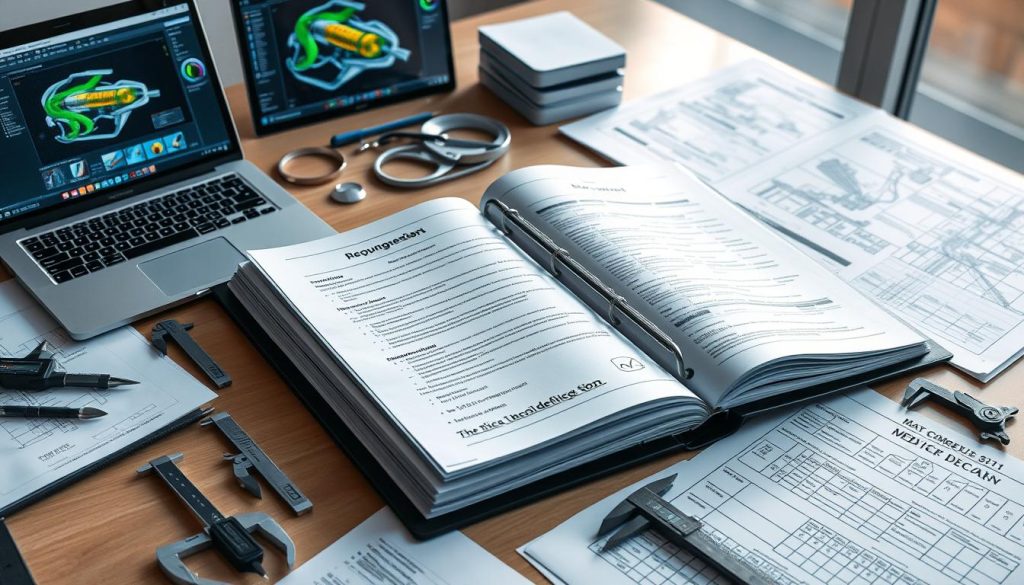
Post-Market Surveillance Responsibilities
Post-market surveillance is key in the life of medical devices. It makes sure devices keep meeting regulatory standards. We need strong systems for reporting to watch how devices perform and handle risks after they’re sold. Our dedication to these tasks boosts safety and supports innovation.
Monitoring and Reporting Obligations
We must follow strict monitoring rules, especially for class II and class III devices. New rules set clear criteria for detailed post-market checks. Knowing these rules is vital to keep the CE marking and meet safety standards.
Our post-market surveillance system should have:
- A detailed plan for post-market surveillance.
- Steps for reporting serious incidents and actions to reduce risks.
- Regular checks of data to spot trends or safety issues.
- Collecting user feedback to improve device safety and effectiveness.
These steps help us spot and fix problems quickly. We must act fast when serious incidents happen, doing thorough investigations and reporting back to regulators. This careful approach ensures we meet current rules and get ready for future changes.
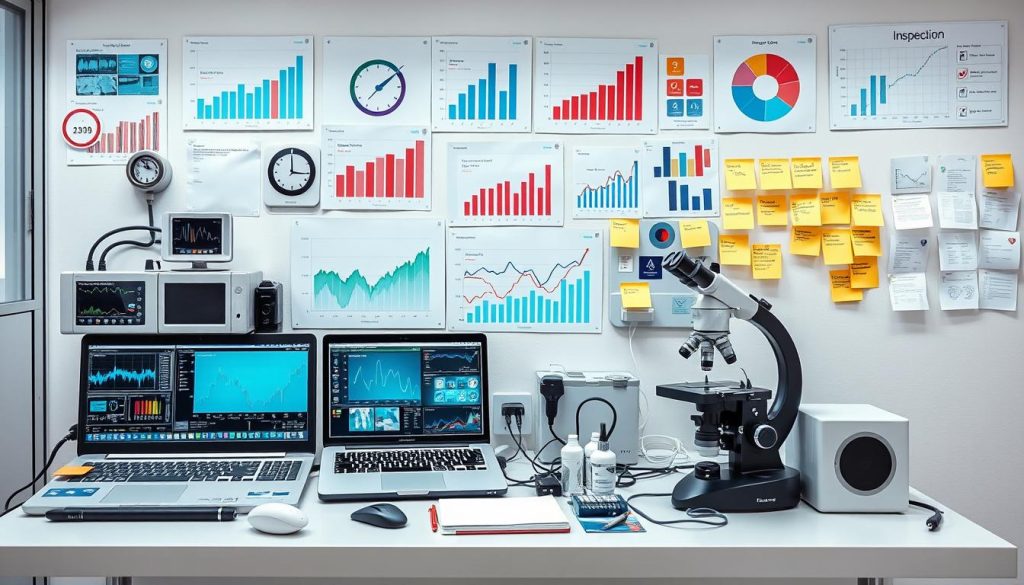
Marketing Your Medical Devices in Italy
Marketing medical devices in Italy needs a deep understanding of the market and strategies. We must know the rules and reach our audience, which includes doctors and patients. The EU Medical Device Regulation (EU MDR) guides our marketing, focusing on safety, quality, and performance.
Understanding Market Dynamics and Strategies
To win in Italy, our marketing must meet rules and show local market understanding. Being compliant is key in our campaigns. We must make sure all ads are accurate, truthful, and follow EU MDR and local laws.
- Ads must show what medical devices are for.
- Italy has its own rules for clinical data, so we need to document well.
- When talking to patients, we must be clear and not make false promises.
- Online marketing is possible, but we must follow local rules.
Working with local distributors helps us get noticed and build strong healthcare ties. Team up with distributors who know Italy well. They can share local marketing tips, helping us get into healthcare places better. Knowing what decision-makers want lets us tailor our messages well.
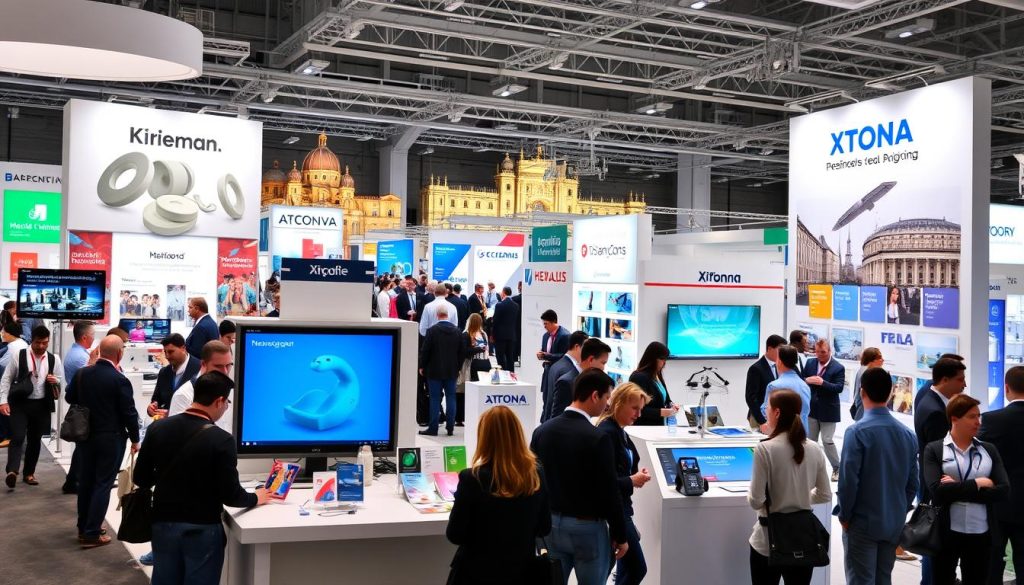
When planning our marketing, we keep in mind the rules, especially for patient ads in Italy. We create careful content to guide device use wisely. This way, we avoid misleading people and build trust in our medical devices in Italy.
Funding Options for Your Medical Device Company
Starting a medical device company in Italy means knowing about funding options. We can use government incentives to help with innovation in healthcare. The National Recovery and Resilience Plan (NRRP) offers financial support for medical devices.
Government Grants and Incentives
Italy has many government grants for medical device companies. The Small Business Innovation Research (SBIR) gives grants from tens of thousands to hundreds of thousands of euros. These grants help with early-stage innovations and reduce financial stress.
The MedTech Funding Mandate (MTFM) also supports affordable medical technologies. It ensures we can offer cost-effective solutions within the NHS. To get MTFM support, we must show our technologies are effective and cost-saving within three years.
Securing Investment and Partnerships
Getting investment from venture capital or angel investors is key. Firms like Felicis Ventures and New Enterprise Associates often support medical devices. Angel investors provide smaller amounts, from tens of thousands to a few million euros, which is crucial at certain times.
Strategic partnerships are also vital. They help us understand the healthcare world better and gain resources. These partnerships can lead to joint ventures and shared innovations, helping us succeed in a fast-changing market.

Building Business Networks in the Italian Medical Sector
Building strong business networks is key to success in Italy’s medical device market. By creating solid distributor relationships, we can reach more customers and gain local insights. Working with local distributors helps us use their networks to distribute medical devices smoothly across different areas.
Establishing Relationships with Distributors
Understanding the local market and healthcare systems is vital. Local distributors know the market well, which helps us work better together. They also help us understand and navigate Italy’s healthcare world.
- Find top players in the medical device field, especially those known for good distributor ties.
- Go to industry events and trade shows to make connections and find partners.
- Use digital tools and cloud solutions for smart decisions and clear communication.
- Take advantage of government support for local business partnerships in medical tech.

Challenges Faced by New Medical Device Companies
Starting in the medical device industry is tough. We face many challenges that can affect our success. It’s key to know these challenges to make good business plans for the future.
Common Pitfalls and How to Avoid Them
New companies often struggle with regulatory compliance. Many face problems keeping up with rules, especially for international markets. Knowing the standards of over 30 countries is crucial.
Another big challenge is not knowing the costs of entering the market. Doing good market research helps us understand our target audience and plan for expenses.
A strong quality management system (QMS) is essential. The medical field requires high-quality equipment. A QMS helps ensure quality and reduces defects. Also, having multiple suppliers helps avoid supply chain problems.
Keeping up with new technology is hard but important. Adapting to new standards is a challenge. Protecting our ideas from being stolen is also vital.
Medical device security is becoming more important. With more connected devices, security risks are growing. Manufacturers must check their security measures carefully.
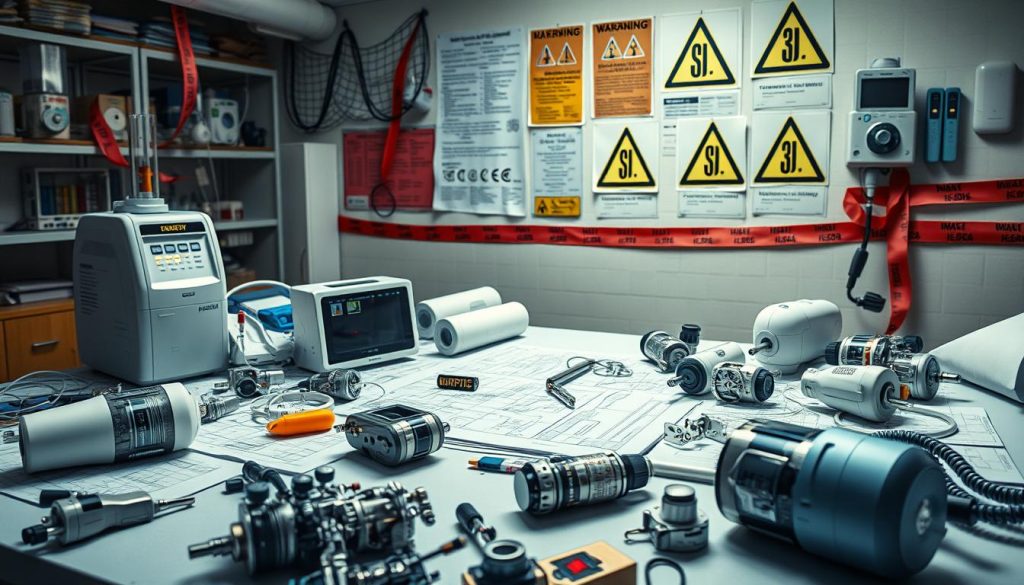
There’s also a shortage of skilled workers in the industry. Finding and keeping good staff is getting harder. We might need to change where we make things or work with partners abroad.
In short, knowing the challenges and planning well can help us succeed in the medical device world.
Benefits of Partnering with Local Expertise
Working with local experts in the medical device field brings big benefits. They know the Italian market well, giving us insights into its culture and key players. This helps us understand the market better and follow important rules.
Partnerships do more than just help us enter the market. For example, teaming up with universities lets us use a wide range of skills to tackle health problems. Programs like SBRI Healthcare, supported by the NHS, show how we can create new solutions that help patients.
By working with NHS partners, we get access to lots of data and medical knowledge. This is great for making decisions based on facts in the medical device world. Also, working with tech providers and regulatory advisors helps us run smoothly and follow rules better.
Outsourcing tasks we don’t do best helps us work faster and cheaper. This lets us test and launch products quickly, saving money and focusing on what we’re good at. Using local talent through partnerships also makes our products better and more compliant, growing our market share.
In short, using local expertise helps us grow in the medical device industry. It lets us innovate by using what we already know and who we already work with. As we build these partnerships, we lay a strong base for future growth and teamwork, improving support for the medical device industry.
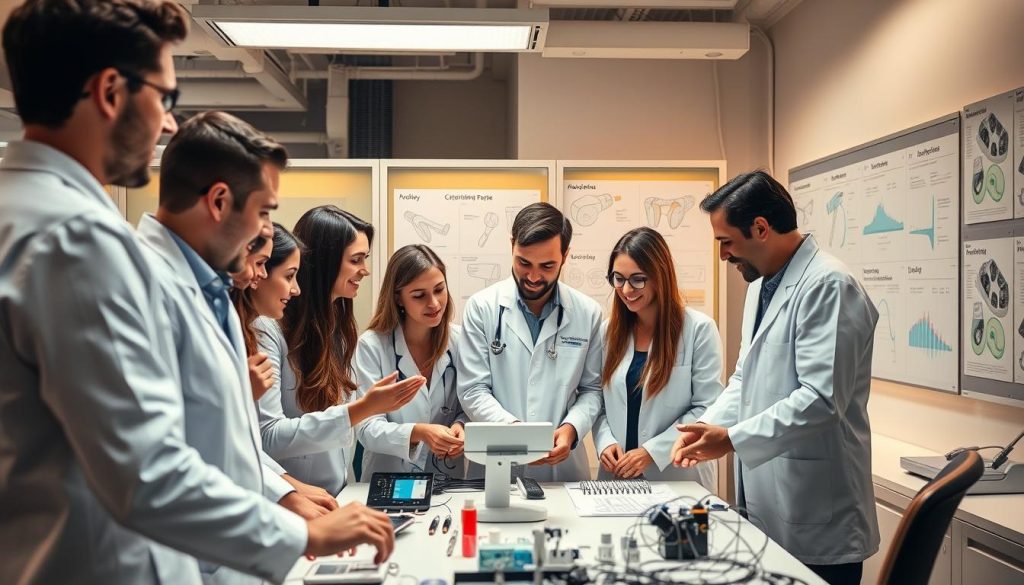
Future Trends in the Italian Medical Device Market
The Italian medical device market is set for a big change, moving towards value-based healthcare. This change puts a spotlight on innovation and the need for better technology. It’s key to understand these trends to stay ahead in the changing healthcare world.
The market for medical devices, especially in medical refrigeration, is expected to grow a lot. It will go from about $4.89 billion in 2024 to $6.84 billion by 2028. This growth rate of 8.8% shows a bright future for those ready to adapt. Europe’s medical devices market is also set to reach USD 87.12 billion by 2032, showing a strong commitment to innovation.
The COVID-19 pandemic has made wearable tech and patient monitoring devices more in demand. This shows how important it is to be flexible and ready for new challenges. Knowing these trends will help us improve our products and stay ahead in the market.

